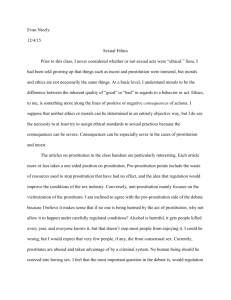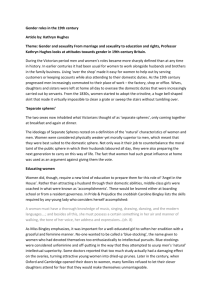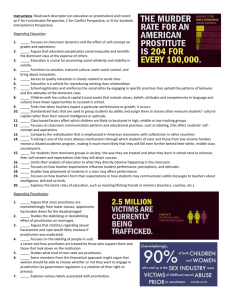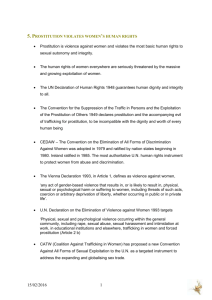`Challenging Men`s Demand for Prostitution in
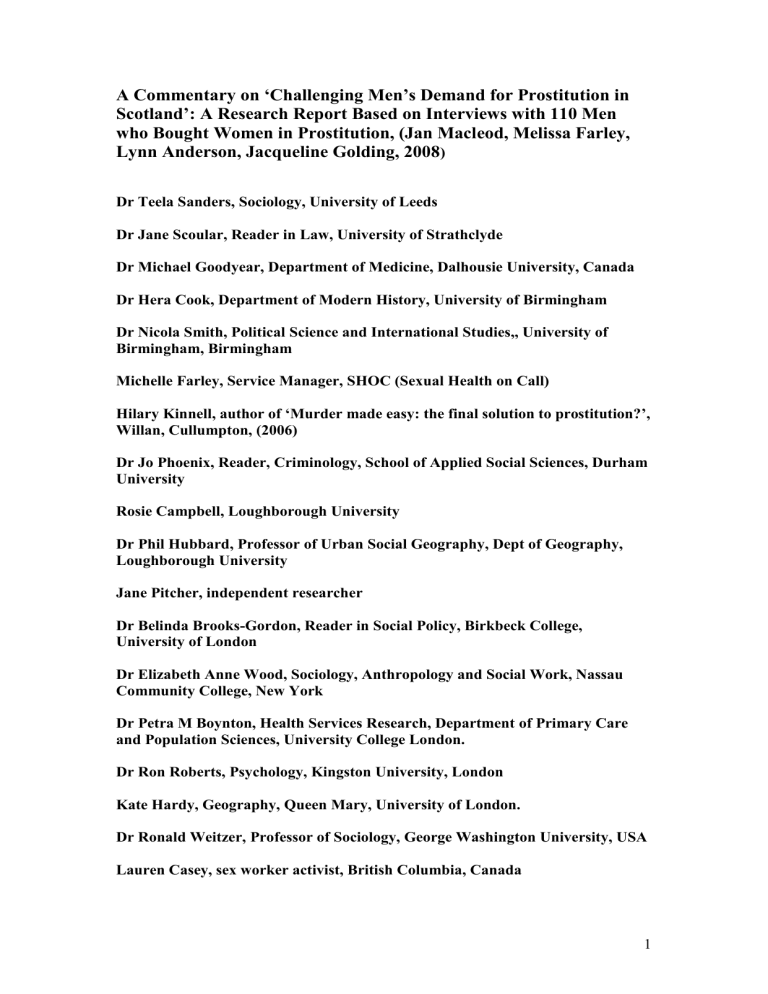
A Commentary on ‘Challenging Men’s Demand for Prostitution in
Scotland’: A Research Report Based on Interviews with 110 Men who Bought Women in Prostitution, (Jan Macleod, Melissa Farley,
Lynn Anderson, Jacqueline Golding, 2008
)
Dr Teela Sanders, Sociology, University of Leeds
Dr Jane Scoular, Reader in Law, University of Strathclyde
Dr Michael Goodyear, Department of Medicine, Dalhousie University, Canada
Dr Hera Cook, Department of Modern History, University of Birmingham
Dr Nicola Smith, Political Science and International Studies,, University of
Birmingham, Birmingham
Michelle Farley, Service Manager, SHOC (Sexual Health on Call)
Hilary Kinnell, author of ‘Murder made easy: the final solution to prostitution?’,
Willan, Cullumpton, (2006)
Dr Jo Phoenix, Reader, Criminology, School of Applied Social Sciences, Durham
University
Rosie Campbell, Loughborough University
Dr Phil Hubbard, Professor of Urban Social Geography, Dept of Geography,
Loughborough University
Jane Pitcher, independent researcher
Dr Belinda Brooks-Gordon, Reader in Social Policy, Birkbeck College,
University of London
Dr Elizabeth Anne Wood, Sociology, Anthropology and Social Work, Nassau
Community College, New York
Dr Petra M Boynton, Health Services Research, Department of Primary Care and Population Sciences, University College London.
Dr Ron Roberts, Psychology, Kingston University, London
Kate Hardy, Geography, Queen Mary, University of London.
Dr Ronald Weitzer, Professor of Sociology, George Washington University, USA
Lauren Casey, sex worker activist, British Columbia, Canada
1
Prostitution Alternatives Counselling Education (PACE), British Columbia ,
Canada
April 29 th 2008.
The reason that this report would not be accepted if it was subjected to ordinary academic peer review processes is not because it is biased per se but that the particular form of bias is one that (i) translates the social, economic, political and ideological realities of commercial sex and the complexity of the relationships involved into more or less 'simple' questions of violence or lack thereof, (ii) transposes what might be economic questions or other questions and realities into gender i.e. everything is the result of gender, and (iii) conflates fundamentally different social phenomena (rape, paedophilia and other forms of sexual violence) in a way which closes off understanding rather than opens it up.
In this way, this report makes no contribution to our understanding of either the
'problem' or the solution. As to criminalising clients (and invoking the same procedures and punishments and rehabilitation as those convicted of very serious sexual offences such as rape and child sexual abuse) the authors of this report are seemingly ignorant of even the most basic legal principles such as the principle of proportionality and ignorant of the actual mechanisms through which criminal justice is dispensed. The report makes no attempt to understand either the men concerned or the phenomenon, to explore the determinants of behaviour or to set these within the broader cultural context. Rather it attempts to take complex relationships and impose simple models of gender and violence.
This research violates fundamental principles of human research ethics in that there is no evidence of any benefit to the population studied. Rather the purpose of the research appears to have been to vilify the population of men who were chosen to be interviewed. It seems highly unlikely that the participants were ever informed of the true nature of the research, which could well have influenced their response. This sort of research is dangerous. The men who were interviewed will be able to read their comments juxtaposed with hostile comments from the investigators. It is quite likely that this could result in significant psychological damage. No evidence is supplied that the interviewees agreed to have their comments reproduced in this form, and it is possible that they could be identified, and suffer social stigmatisation. The research appears to have prejudged the issues, and the investigators make no attempt to disguise their contempt for their subjects. This hostile environment is not conducive to objective and reproducible research. The interviewees were drawn from a group with strong prejudices against men who buy sexual services. It is hard to imagine any research committee authorising a situation in which two groups, as here, are placed together in what virtually constitutes gladiatorial conditions.
This research on which this report is based was not grounded in empirical research ethics or a critical, objective method of producing knowledge. There appears to be no ethics approval or peer review in terms of the design and execution of the project.
There is no evidence that participants were asked for informed consent and no
2
information is given regarding the ethical protocols that were followed. Similarly, though the survey methodology is described, details of the questions asked are not provided. It is standard practice that questionnaire instruments are included in an
Appendix for scrutiny. The report was published in-house by the Women's Support
Project. This is outside the normal academic peer review process and therefore it is not entirely surprising that the report is not of an acceptable academic standard.
The report is based on the particular radical standpoint which holds that prostitution is violence towards all women and that voluntary consensual engagement in the sex industry is not possible. This standpoint, explicitly stated in the introduction, means that the research is shaped by this perspective, leaving no opportunity for other viewpoints to be expressed or for alternative realities other than this extreme version of prostitution to be valid. The problems with the dissemination and distortion of the findings largely, though not solely, stem from this bias in the research:
1.
In this report the male interviewees are cast as offenders and men who perpetrate violence against women. There is, however, no analysis of the men's criminal records, or any evidence that they have committed offences for which they may have been committed and sentenced by the courts. Previous peer reviewed research would suggest that the majority of these men were law abiding citizen (Hester and Westmoreland, 2004). In addition, the participants who were paid for their time, would clearly not have signed up to fraudulent
‘research’ which depicted them as criminal sex offenders.
2.
It is assumed that all of the 110 interviewees who buy sex commit actual sexual violence against women. This is irresponsible and again suggests informed consent was not obtained from the participants.
3.
There is limited review of other research methodology with men who buy sex and in particular that research in which evidence contrary to the investigators’ known views is presented. See for instance:
Grentz, S. (2005) 'Intersections of Sex and Power in Research on Prostitution: A Female
Researcher Interviewing Male Heterosexual Clients', Signs: Journal of Women in
Culture and Society 30(4): 2091-2113.
Peng, Y. W. (2007) 'Buying Sex. Domination and Difference in the Discourses of Taiwanese
Piao-ke', Men and Masculinities 9(3): 315-336.
4.
Rape myths – the assumptions that such negative attitudes are held by the majority of male clients is a misrepresentation and a distortion of the report’s own findings. It is stated on page fourteen that less than a quarter of the interview subjects (22%) made associations between sex workers and sexual violence. This means that the majority of men interviewed did not make these links and did not hold distorted views about sex workers ‘deserving’ sexual violence.
5.
In addition, the researchers ignore established large-scale research on this topic by Monto and Hotaling (2001). This study explores the level of "rape myth acceptance" and men arrested the predictors of rape myth acceptance among 1,286 for trying to hire street prostitutes in San Francisco (n = 950), Las
Vegas (n = 254), and Portland, Oregon (n = 82). Results indicate low levels of rape myth acceptance among respondents, although a small number of men expressed higher levels.
3
Monto, M. A. and Hotaling, N. (2001) 'Predictors of Rape Myth Acceptance Among Male
Clients of Female Street Prostitutes', Violence Against Women 7(3): 275-293.
6. The report does not acknowledge that men can engage in the sex industry in a respectable, non violent manner, or that they may be aware of the issues of exploitation and unfair treatment of sex workers. A recent study of 50 men
(Sanders, 2008) demonstrated that some men who engage with sex workers are aware of issues relating to giving over money to third parties, are concerned about exploitation by brothel owners and coercive working practices, particularly of non-nationals and therefore bought sex mindful of these issues. Suggesting that all men who buy sex from women are not responsible is vastly over generalising assumptions and making inferences that do not stand up in people’s lived realities.
7. Conceptualising sex work unproblematically as violence against women invisibilises the large number of female clients of sex workers as well as male and transgender sex workers. Similarly, the continued use of discourses of ‘prostitution’ and ‘prostitutes’ denies the right to selfdetermination and identity formation to individuals and groups who are mobilising in Scotland and across the world for recognition that they are sentient subjects able to articulate their own interests and needs. Not only is this lack of recognition dangerous and unhelpful, it is also profoundly disrespectful.
8.
The researchers not only advocate the criminalisation of men who buy sex, but they suggest such men should be categorised as sex offenders, include placing them on the sex offender register. In the report men who buy sex are categorised with ‘rapists, paedophiles and other social undesirables’ (pp 27).
This extreme view discounts the following important realities: a.
The majority of commercial sexual interactions are without violence or robbery b.
The majority of commercial sexual interactions are consensual between adults. c.
There is ample counter evidence (such as Bernstein, 2001;2007) that indicate that clients are 'normal' and increasingly seeking 'authenticity', intimacy and mutuality rather than trying to fulfil any mythology of violent, non-consensual sex. d.
Certain groups of men, such as those living with disabilities, would be marginalised as rapists following the distorted logic of this report. e.
Advocating sending men to jail vastly misunderstands the use of the criminal justice system and the issues of overcrowding. f.
Penal sanctions for buying sex has serious human rights implications g.
Criminalising men who pay for sex in any capacity has a significantly damaging effect on sex workers and therefore, as a policy, increases violence against women.
9.
There is a lack of understanding of the research done on men who buy sex including important works in recent years:
Brooks-Gordon, B. (2005) 'Clients and Commercial Sex: Reflections on Paying the Price: A
Consultation Paper on Prostitution', Criminal Law Review : 425-443.
4
— (2006)
The Price of Sex: Prostitution, Policy and Society : Willan Publishing.
Campbell, R. (1998) 'Invisible Men: Making Visible Male Clients of Female Prostitutes in
Merseyside', in J. Elias, V. Bullough, V. Elias and G. Brewer (eds) Prostitution. On
Whores, Hustlers and Johns , New York: Prometheus Books. pp. 155-171
Campbell, R. and Storr, M. (2001) 'Challenging the Kerb Crawler Rehabilitation Programme',
Feminist Review 67(Spring): 94-108.
Kinnell, H (2006) 'Clients of Female Sex Workers: Men or Monsters?' in R. Campbell and M.
O'Neill (eds) Sex Work Now , Cullumpton:Willan. pp. 212-262
Lowman, J., and Atchison, C., (2006) 'Men Who Buy Sex: A Survey in the Greater
Vancouver Regional District', Canadian Journal of Sociology and Anthropology
43(3): 281-296.
O'Connell Davidson, J. (2003) ''Sleeping with the Enemy'? Some Problems with Feminist
Abolitionist Calls to Penalise Those Who Buy Commercial Sex', Social Policy and
Society 2(1): 55-64.
Phoenix, J. and Oerton, S. (2005) Illicit & Illegal. Sex, Regulation and Social Control ,
Cullompton: Willan.
Perkins, R. (1999) ‘How much are you love?’ The customer in the Australian sex industry.
Social Alternatives 18(3) 38-47
Sanders, T (2008) Paying for Pleasure: Men who Buy Sex, Willan, Cullompton
Scoular, J. (2004) 'Criminalising 'Punters': Evaluating the Swedish Position on Prostitution',
Journal of Social Welfare and Family Law 26(2): 195-210.
Van Brunschot, E. G. (2003) 'Community Policing and "John Schools"', Canadian Review of
Sociology and Anthropology 40(2): 215-232.
10.
The study interviewed a selection of men who responded to the newspaper advertisements. The researchers make an unjustifed assumption that the subjects are representative of men who buy sex in general, and that they are distinguishable from the population as a whole. There is neither a control group, nor any attempt to compare their sample to population data. The views expressed by these men could easily be representative of men in general of similar age and socioeconomic characteristics. Previous research that suggests that men who buy sex are in fact indistinguishable from the general population is ignored.
11.
The report makes a series of recommendations based on these interviews which completely ignores the basis and workings of the criminal justice system, and in particular the nature of sexual offences
12.
The researchers were defined as people wanting to end violence against women - but presumably this may introduce bias into how the research was run. If you are asking someone to disclose buying sex but you openly disagree with this how can you hear what they say? This poses risk to both participant and researcher, and presumably the wellbeing of both is compromised by hiring researchers in this way. Why wasn't this assessed by the funding body/ethics committee? If researchers were traumatised then a proper risk assessment may well not have been completed at the start of the study. Such standard practice is there to minimise this problem and offer support to those in the study. The study appears to have neglected the safety and wellbeing of participants and researchers - although there is adequate evidence on how to do safe research with sensitive subjects. While a reflexive analysis is useful, opening any report stating how traumatised the researchers were is a shocking
5
misrepresentation of findings and a basic admission of poor research management.
6




